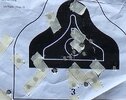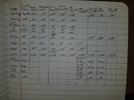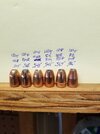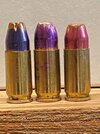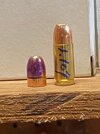Consensus on........COAL.......and maybe load data to follow.
Consider this:
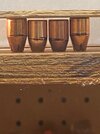
From left to right: - line on bullet is where nose stops when inserted into empty case......ballpark area where bullet will engage lands when fired:
Hornady 124 gr XTP recommended COAL = 1.060
RMR 124 gr Nuke recommended COAL = ???
Sierra 125 gr JHP recommended COAL = 1.030
Hornady 124 gr. XTP same
As can be seen, when loaded to same COAL, both the RMR nuke and Sierra are not going to be seated as deep. RMR nuke and Sierra are almost exact twins, except nuke is actually 0.005 shorter.
Well known warning......all things being equal, seating deeper can increase the pressure. If that is true, then it must follow that not seating as deep decreases pressure. Sierra and almost every other source of load data out there has this 125 jhp seated to 1.030. The lone exception I'm aware of is Lyman 50th, which has load data seated to 1.075. Their powder loads are jackeup up over what Sierra and other listing it show. But certainly not out to 1.120 or so that old nuke load data shows.
So lacking exact load data for the new RMR nuke, what to do? Use data for the old nuke, which had a longer nose profile? Use data for the Sierra, exactly as is? Use Lyman data for Sierra 125 JHP?
So far, I've been using load data for the Hornady 124 gr XTP......which is found in abundance...... and loading nuke to same 1.060, which it clearly does not match up to, but seems uber safe way to do it.
Stay with that plan or ????????
Consider this:

From left to right: - line on bullet is where nose stops when inserted into empty case......ballpark area where bullet will engage lands when fired:
Hornady 124 gr XTP recommended COAL = 1.060
RMR 124 gr Nuke recommended COAL = ???
Sierra 125 gr JHP recommended COAL = 1.030
Hornady 124 gr. XTP same
As can be seen, when loaded to same COAL, both the RMR nuke and Sierra are not going to be seated as deep. RMR nuke and Sierra are almost exact twins, except nuke is actually 0.005 shorter.
Well known warning......all things being equal, seating deeper can increase the pressure. If that is true, then it must follow that not seating as deep decreases pressure. Sierra and almost every other source of load data out there has this 125 jhp seated to 1.030. The lone exception I'm aware of is Lyman 50th, which has load data seated to 1.075. Their powder loads are jackeup up over what Sierra and other listing it show. But certainly not out to 1.120 or so that old nuke load data shows.
So lacking exact load data for the new RMR nuke, what to do? Use data for the old nuke, which had a longer nose profile? Use data for the Sierra, exactly as is? Use Lyman data for Sierra 125 JHP?
So far, I've been using load data for the Hornady 124 gr XTP......which is found in abundance...... and loading nuke to same 1.060, which it clearly does not match up to, but seems uber safe way to do it.
Stay with that plan or ????????


